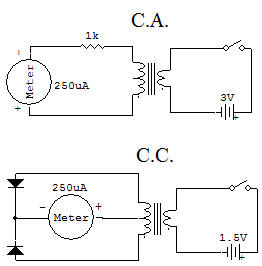
Power generation

The purpose of this project is to prove that a Transformer can only induce a voltage in a winding when the current is changing in the source winding. The source winding is connected to the 3V Battery through the Key. This allows you to apply and remove Battery current easily and abruptly.
The second (secondary) winding is coupled to the Meter through a 1K Resistor. Because the Meter has a resistance of about 650 ohms and requires about 0.25mA (250uA) of current to obtain a full-scale deflection, this circuit acts like a 400mV (millivolts) voltmeter.
Circuit action is as follows:
1. The Meter deflects only when the Key is opened or closed.
2. No Meter deflection occurs when toe Key is closed and DC current is flowing in the source (primary) winding.
3. Meter deflection is in one polarity when the Key is closed and in the opposite polarity when the Key is opened. (Reverse the meter connections to verify this more clearly.)
The induced secondary voltage is caused by the changing magnetic flux within the Transformer.
The "cutting of flux lines" or the "changing of flux density" is required to move electrons within the turns of wire and therefore generate the "induced" voltage.
Try opening and closing the Key faster and faster. You can see by this why AC (alternating current) can pass through a Transformer efficiently. Can you think of a component that DC can pass through efficiently while AC is virtually stopped or choked off?
